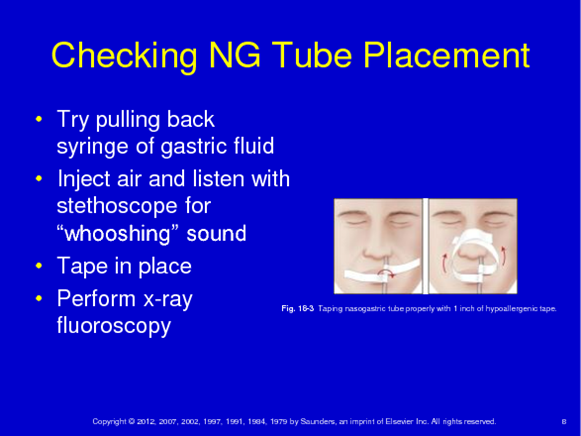A nurse is preparing to administer an intermittent enteral feeding to a child who has an NG tube in place. Which of the following actions should the nurse take first?
Place the child in an upright position.
Verify the position of the NG tube.
Determine the gastric residual volume.
Flush the child's NG tube with sterile water.
The Correct Answer is B
Choice A reason:
The nurse should prioritize Choice B over Choice A as it is essential to first confirm the correct placement of the NG tube before proceeding with any other actions. If the tube is not correctly positioned, administering the enteral feeding can lead to potential complications, such as aspiration, which can be life-threatening. Therefore, it is crucial to ensure the NG tube's proper placement before moving forward with the feeding
Choice B reason:

This option takes precedence as verifying the NG tube's position is a fundamental step in the enteral feeding process. The nurse must use appropriate methods, such as X-ray or pH testing, to confirm that the tube is in the stomach and not in the respiratory tract or elsewhere. This verification ensures the safety and effectiveness of the feeding procedure and prevents potential harm to the child.
Choice C reason:
While checking the gastric residual volume (GRV) is an important step in some cases, it should be done after confirming the NG tube's proper placement (Choice B). GRV provides information about the amount of feeding left in the stomach and helps in assessing tolerance to the feeding. However, if the NG tube is misplaced, determining GRV becomes irrelevant as the feeding would not be going to the intended location.
Choice D reason:
Flushing the child's NG tube with sterile water is an appropriate step during the enteral feeding process but should be done after verifying the tube's position (Choice B). Flushing ensures that the tube is patent and free from any obstructions, allowing the feeding to pass through smoothly. However, again, if the NG tube is incorrectly positioned, flushing it would not address the underlying issue.
Nursing Test Bank
Naxlex Comprehensive Predictor Exams
Related Questions
Correct Answer is C
Explanation
Choice C reason: The correct answer is choice C, "I need to use my levalbuterol inhaler before I exercise.” This statement indicates an understanding of the teaching because using the levalbuterol inhaler before exercise is a preventive measure for asthma symptoms. Levalbuterol is a short-acting beta-agonist that helps to relax the airway muscles and improve breathing. By using it before exercise, the client can prevent exercise-induced bronchoconstriction and reduce the risk of asthma symptoms during physical activity.
Choice A reason:
The statement "I will wait 15 seconds between puffs when using my levalbuterol inhaler” is incorrect. The recommended wait time between puffs of a levalbuterol inhaler is typically 30- 60 seconds to allow the medication to be fully absorbed and work effectively. Waiting only 15 seconds might not provide the desired therapeutic effect.
Choice B reason:
The statement "I need to use my fluticasone inhaler when I start to wheeze during exercise” is incorrect. Fluticasone is a corticosteroid inhaler used for long-term control of asthma symptoms, not for immediate relief during wheezing episodes. The client should use the fluticasone inhaler daily as prescribed to prevent asthma symptoms, including wheezing, from occurring in the first place.
Choice D reason:
The statement "I will stop using my fluticasone inhaler if I experience restlessness” is incorrect. Fluticasone is a long-term controller medication, and abruptly stopping it can lead to uncontrolled asthma symptoms and potentially exacerbate the condition. Restlessness might be a side effect of the medication, but it is not a reason to discontinue its use. If the client experiences any concerning side effects, they should consult their healthcare provider for appropriate management.
Correct Answer is C
Explanation
Choice A reason:
The statement "I will discard insulin bottles 60 days after opening”. is incorrect. Insulin bottles typically have a shorter shelf life after opening, usually around 28 days. Discarding them after 60 days could lead to using ineffective insulin, which can be harmful to the individual's blood sugar control.
Choice B reason:
This statement is incorrect. Excessive insulin use can cause hypoglycemia which is aggravated by involvement in streneous exercise.
Choice C reason:
The statement "If I feel dizzy, I will drink 4 ounces of orange juice”. is correct. A feeling of dizziness is an early sign of hypoglycemia. Client should be encouraged to take simple acrbohydrayes when tehy experience any symptoms consistent with hypoglycemia
Choice D reason:
The statement "A hemoglobin A1c of 9 percent is a good goal”. is incorrect. Hemoglobin A1c reflects average blood sugar levels over the past 2-3 months. An A1c of 9 percent is relatively high and suggests poor diabetes management. The target A1c goal for most people with diabetes is typically below 7 percent, as recommended by the American Diabetes Association.
Whether you are a student looking to ace your exams or a practicing nurse seeking to enhance your expertise , our nursing education contents will empower you with the confidence and competence to make a difference in the lives of patients and become a respected leader in the healthcare field.
Visit Naxlex, invest in your future and unlock endless possibilities with our unparalleled nursing education contents today
Report Wrong Answer on the Current Question
Do you disagree with the answer? If yes, what is your expected answer? Explain.
Kindly be descriptive with the issue you are facing.
